History of Cherwell Valley services
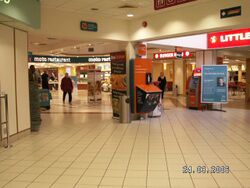
Inside the original building, pictured in 2006. The pillar marks where the old entrance was, with Little Chef (right) and M&S (far left) in extensions.

Two service area buildings have been built beside Stoke Lyne Brook, not including the emergency toilet facilities. All evidence of the original building is gone, but it remains documented here.
Location Planning
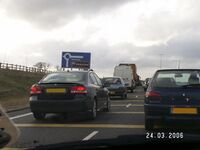
See also: M40 Service Area Planning
As far as major motorways go, the M40 was one of the last to open in Britain. It had to tip-toe around environmental and political issues, and the service station planning was poor. After the M40 opened in 1991, it was possible to drive from Folkestone to Telford (236 motorway miles) without passing any service areas and, as a result, when Cherwell Valley did open in 1994, it became the busiest service area in Europe and an important point on the road network.
While the M40 was being planned, the Department of Transport considered a number of vague areas where service areas could be built, including "near Bicester". In 1983 they examined six possible locations: Ardley Junction (M40 J10), Trow Pool, Bucknell Road, two by the B4030 and Chesterton Fields Farm.
Meanwhile Oxfordshire County Council conducted a large review of parking facilities in their county, and concluded that all of their needs could be met with a single service station built at either M40 J9 or M40 J10. They later concluded M40 J10 would be the best place to build a service station, and the Department of Transport agreed.
At the time, there were only a few miles of motorway in Oxfordshire, so you can forgive them for making such a critical mistake. They were acting on the understanding that it's better to have one big service station than several small ones, for environmental and traffic flow reasons, which is true but more relevant to quiet A-roads. They thought the fact that Cherwell Valley would be serving so many different routes at once, including local residents using the B430, was a major bonus. The decision was made in 1984.
The Department of Transport probably should have known that making one service station so important and then placing it at a small and busy roundabout was going to cause issues. Problem was they had been struggling to convince operators to work with them, so to them "too busy" would be a major selling point when it came to convincing a developer to build here. They had previously clashed with local authorities over service station planning, so they were happy to have Oxfordshire on board. They considered a number of alternative sites, but ultimately approved the Cherwell Valley proposal and decided to take it forward, identifying a 56 acre site at the junction.
The strategy was agreed in 1986, but it took several more years to sign contracts and get the service area built, partly because of the fallout from the High Court case over Clacket Lane, which had criticised the Department's procedures. As a result, when the M40 was built, emergency toilet facilities were provided at this junction until the service area was ready.
The contract was won by Esso, who usually went into partnership with Granada. The construction contractor was Mace.
Traffic and Roadworks
M40 J10 was always busy, but initially it did flow well. Problems came in 2002 when the A43 was upgraded to provide a consistent dual carriageway to Northampton, and that project included upgrading J10 with an 'improvement' scheme that made things considerably worse. There is an argument that the new road layout was compromised because it had to work around (and provide access to) the service area, and while that may be true, it doesn't excuse how bad the new layout was. From this year onwards, Cherwell Valley would become notorious for its long queue to get into the service area from the M40 northbound. Moto sought compensation for lost custom due to the upgrade, but were unsuccessful.
The junction was 'improved' again in 2015, which resulted in more roadworks, more road closures and more teething issues. In 2016 Moto placed signs on the exit from their service area, providing journey times to "the Highways Agency's traffic signals" - a wording that suggests they were unhappy that their customers were being affected by the delays. Even more roadworks are planned as part of the railfreight project.
As of 2019, Cherwell Valley is now one of Moto's busiest and most profitable sites. This will be partly down to the new building, and partly thanks to the Department of Transport's theory that a busy junction would be more lucrative.
Design and Opening
The Telegraph, 1994
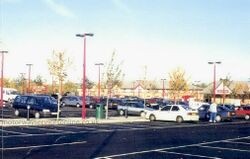
The original Cherwell Valley was a bit of a landmark design, as it was one of the first service areas to take advantage of its backdrop to create a more relaxing environment. It was a low-level building draped in trees and designed to resemble a country house, and the entrance to the car park still creates the impression of a driveway today.
Granada claimed this was to meet changing customer demands, but the 120,000 trees they planted and the new hills they created also helped get the site through the planning process. They also built four ponds, reclaimed a stream, created areas of meadowland and introduced management schemes for three woods. A consultation was held to gather suggestions from HGV drivers.
The western end of the car park and the southern end of the HGV park were initially left empty, and were built at a later date. Parking was provided for 385 cars, 70 HGVs and 20 coaches, with an overnight stop costing £8 (around £16 in 2025).
This effect didn't necessarily last: compared to bigger, brighter buildings which were later built it looked cramped and extensions in the 1990s made the front of Cherwell Valley look like any supermarket from the time, but even so, many service areas took inspiration from it.
It was opened on 31 March 1994 by Michael Heseltine MP. The total investment was £20million (worth around £41million). Construction was completed in just 11 months, which was six months sooner than expected: this, combined with the high demand, meant that it was short-staffed and over-worked for the first few months. At the end of 1994 Granada said Cherwell Valley was doing "spectacularly well", and it was now their third busiest site.
Original Building
The building was initially painted bright red, and had an entrance in the middle with a small point, similar to the 'Essex Barn' style used which was being used by supermarkets. It was designed for a "high throughput".
Inside, the service area opened with a Burger King in the right-hand corner; a 350-seat Granada Restaurant dining area overlooking the river straight ahead; a Granada Shop on the left and a corridor leading to the toilets and an amusement arcade at the back. A Little Chef was later built in the corner in February 1997, next to Burger King. A large patio area had been included at the front, allowing for expansions like that.
Next to the main building was the Granada Lodge, which was painted bright white and had 64 beds. This soon became Travelodge.
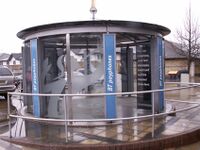
In 1999, Granada proposed extending the restaurant area to include a formal coffee lounge over the area surrounding the children's play area, with a new, larger play area being built behind the building. The planned lounge would have included a reception, 8 private rooms, 12 personal workstations and a terrace with picnic tables stretching over the area between the main building and the hotel. There would have also been a "BT Communications Room", which was eventually built as a separate building.
A new entrance was created to the left of the original in 2000, creating some additional shopping units (one of which was Thorntons), workspaces and a new entrance lobby with a coffee shop inside it. This was supposed to house 'Granada 2 Go', an express food store - the idea may have been short-lived or dropped in favour of Upper Crust or Caffè Ritazza. This was intended to have a large, paraboloid roof, but instead it opened with a more discrete, supermarket-style entrance. A new games arcade was placed in the old entrance.
The motorway network's second M&S Simply Food store opened here on 11 November 2004, utilising some of the existing shop space. By late 2007, the remaining shop had become a WHSmith store. The Fresh Express and Little Chef had both closed by April 2008, later becoming a free-flow restaurant known as 'Moto Restaurant'. A Costa later utilised some of the space too, with Ladbrokes at the back in the old game arcade area.
There was also a plant room built between the hotel and the main building which was originally a tourist information centre. There were plans to connect this to the main building but this didn't happen.
The M&S and Travelodge were later extended. A pathway between the building and hotel pointed the way to a walk around Stoke Lyne Brook.
Fire

On 15 April 2010 at 1pm there was a fire in a store room which took hold of the roof and eventually destroyed the whole amenity building, narrowly missing the adjacent Travelodge. It was started by an electrical fault within an air-conditioning unit. Around 120 firefighters tackled the blaze which lasted until 5pm and resulted in delays on the M40 and a closure of the A43.
Heart Oxfordshire have some photos of the fire.
On 23 April 2010 a new marquee-style building opened at the western end of the car park as a temporary measure until better facilities could be set up. It could hold 100 people, served drinks and a limited hot food menu.
The destroyed building was demolished throughout May 2010.
Some better facilities that could house all the expected features opened on 15 July 2010 at the south-eastern end of the car park and were used until the permanent building was ready. This had the building raised on scaffolding. Ladbrokes wasn't included in the temporary building, and didn't return at all.
Replacement
On 1 July 2010 a planning application was made for a replacement amenity building, with Moto claiming design work had started just hours after the fire.
The new design was almost identical to Wetherby, with the same environmental credentials, but had been designed to accommodate busier peak periods and with more units. All the brands (including Thorntons, which was unique to the service area) were set to be included in the new building, but this didn't materialise: a meeting centre opened in place of Thorntons and the planned Ladbrokes opened as Upper Crust.
The Travelodge closed at the same time as the fire. Moto were considering arranging a deal to sell the hotel to Starboard Hotels, which would have incurred a rebrand to Days Inn, but this plan was dropped and it reopened on 26 May 2011 as a Travelodge.
The new building opened on 30 June 2011, shortly before which it was announced that Domino's Pizza would be included. This idea didn't happen and was dropped.
As would be expected from a brand new amenity building, it has no scars from any extensions being built, creating an unmodified rectangle shape that makes it look slightly detracted from its surroundings. The trees around the entrance have been replaced by a patio area.
The new building is much more stylish, but with a large, airy dining area by the entrance facing the car park and the kitchen hiding the views over the meadow, it does look like it is a building design copied from elsewhere.
An official opening ceremony was held on 21 February 2012, attended by Mike Penning MP.
Petrol Station
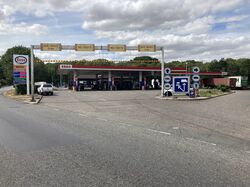
After Esso won the contract to build this service area on Highways Agency land, they sold the majority of it to Granada and retained only the petrol station, which opened with 22 pumps. This meant the petrol station has always been run slightly differently.
Esso sold the petrol station to Euro Garages in 2016, who refurbished it to introduce a new Subway store; this was removed in 2019. Euro Garages have installed signage around much of the service area promoting their portion of the site.
The forecourt shop was rebranded to Asda On the Move in January 2023, in line with their latest partnership. The site transferred to the Asda estate on 6 February 2024, relaunching with a new Asda Express store.
EG Group added four electric vehicle charging points beside the forecourt sales building in late 2023, under their EV Point brand, but these are yet to go live.
The land the main service area was built on continues to be owned by England's national highway authority, except for the petrol station, which appears to have been purchased outright.
Survey Results
In 2025, Which? Magazine ranked Cherwell Valley 18th out of the 90 service areas they visited.
A spin-off Transport Focus survey calculated an 83% satisfaction score among lorry drivers for the service area.
The 2022 Transport Focus survey calculated a 96% satisfaction score for the service area. The following year it scored 93%: a respectable result that still saw it placed in the lower half of the league table.
In 2021, Which? Magazine ranked Cherwell Valley 13th out of the 68 service areas they visited.
In Spring 2018, Transport Focus calculated a 91% satisfaction score for the service area, rising to 95% in 2019.
In 2015, the service area was rated 4 stars by VisitEngland.
In 2013 and 2014 the service area won a platinum loo award.
In May 2013, Cherwell Valley received its first 5 star rating from VisitEngland. It was also Moto's first 5 star rating.
Cherwell Valley was the national motorway service area winner in the 2012 Loo of the Year Awards.
In May 2012, VisitEngland rated the service area as 4 stars. In August 2011, they gave it 3 stars, but it's not clear which building they were grading. The new one was said to have the best design of any service area.
In 2006 the service area was graded 4/5 by Holiday Which?.
In 2005 and again in 2006, the service area won a five star loo award.
